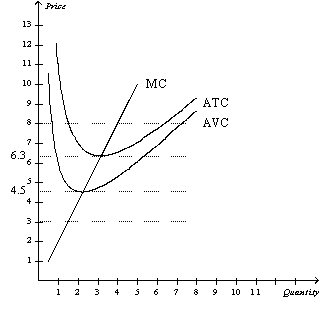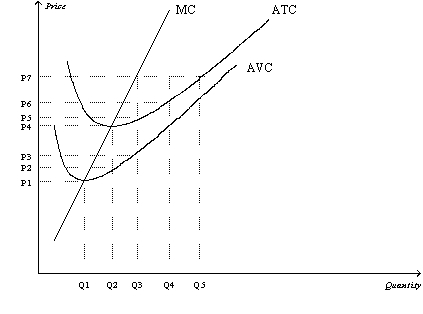Correct Answer

verified
Correct Answer
verified
Multiple Choice
A competitive firm is currently producing a quantity of output at which marginal revenue exceeds marginal cost.In order to increase its profit,the firm should
A) increase the price of the good that it produces and sells.
B) increase its quantity of output.
C) decrease its total cost.
D) decrease its average total cost.
Correct Answer

verified
Correct Answer
verified
Multiple Choice
Figure 14-1
Suppose that a firm in a competitive market has the following cost curves:  -Refer to Figure 14-1.The firm should shut down if the market price is
-Refer to Figure 14-1.The firm should shut down if the market price is
A) above $8.
B) above $6.30 but less than $8.
C) above $4.50 but less than $6.30.
D) less than $4.50.
Correct Answer

verified
Correct Answer
verified
Multiple Choice
Table 14-12
Bill's Birdhouses
 -Refer to Table 14-12.What is the marginal revenue from selling the 5th unit?
-Refer to Table 14-12.What is the marginal revenue from selling the 5th unit?
A) $12
B) $68
C) $80
D) $480
Correct Answer

verified
Correct Answer
verified
Multiple Choice
In a competitive market,the actions of any single buyer or seller will
A) discourage entry by competitors.
B) influence the profits of other firms in the market.
C) have a negligible impact on the market price.
D) None of the above is correct.
Correct Answer

verified
Correct Answer
verified
Multiple Choice
Which of the following is not a characteristic of a perfectly competitive market?
A) Firms are price takers.
B) Firms have difficulty entering the market.
C) There are many sellers in the market.
D) Goods offered for sale are largely the same.
Correct Answer

verified
Correct Answer
verified
Multiple Choice
Suppose a profit-maximizing firm in a competitive market produces rubber bands.When the market price for rubber bands falls below the minimum of its average total cost,but still lies above the minimum of average variable cost,in the short run the firm will
A) experience losses but will continue to produce rubber bands.
B) shut down.
C) earn both economic and accounting profits.
D) raise the price of its product.
Correct Answer

verified
Correct Answer
verified
Multiple Choice
The assumption of a fixed number of firms is appropriate for analysis of
A) the short run but not the long run.
B) the long run but not the short run.
C) both the short run and the long run.
D) neither the short run nor the long run.
Correct Answer

verified
Correct Answer
verified
Multiple Choice
Table 14-1
 -Refer to Table 14-1.If the firm doubles its output from 3 to 6 units,total revenue will
-Refer to Table 14-1.If the firm doubles its output from 3 to 6 units,total revenue will
A) increase by less than $15.
B) increase by exactly $15.
C) increase by more than $15.
D) Total revenue cannot be determined from the information provided.
Correct Answer

verified
Correct Answer
verified
Multiple Choice
In a perfectly competitive market,the market supply curve is
A) the marginal cost curve above average total cost for a representative firm.
B) the horizontal sum of all the individual firms' supply curves.
C) the vertical sum of all the individual firms' supply curves.
D) always a horizontal line.
Correct Answer

verified
Correct Answer
verified
Multiple Choice
In the long run,a firm will enter a competitive industry if
A) total revenue exceeds total cost.
B) the price exceeds average total cost.
C) the firm can earn economic profits.
D) All of the above are correct.
Correct Answer

verified
Correct Answer
verified
Multiple Choice
Table 14-14
The following table presents cost and revenue information for Bob's bakery production and sales.
 -Refer to Table 14-14.What is the total revenue from selling 5 units?
-Refer to Table 14-14.What is the total revenue from selling 5 units?
A) $2.50
B) $3.25
C) $12.50
D) $16.25
Correct Answer

verified
Correct Answer
verified
Multiple Choice
Figure 14-5
Suppose a firm operating in a competitive market has the following cost curves:  -Refer to Figure 14-5.In the short run,if the market price is higher than P1 but less than P4,individual firms in a competitive industry will earn
-Refer to Figure 14-5.In the short run,if the market price is higher than P1 but less than P4,individual firms in a competitive industry will earn
A) positive profits.
B) zero profits.
C) losses but will remain in business.
D) losses and will shut down.
Correct Answer

verified
Correct Answer
verified
Multiple Choice
The Doris Dairy Farm sells milk to a dairy broker in Prairie du Chien,Wisconsin.Because the market for milk is generally considered to be competitive,the Doris Dairy Farm does not choose the
A) quantity of milk to produce.
B) price at which it sells its milk.
C) profits it earns.
D) All of the above are correct.
Correct Answer

verified
Correct Answer
verified
Multiple Choice
For any competitive market,the supply curve is closely related to the
A) preferences of consumers who purchase products in that market.
B) income tax rates of consumers in that market.
C) firms' costs of production in that market.
D) interest rates on government bonds.
Correct Answer

verified
Correct Answer
verified
Multiple Choice
In a perfectly competitive market,the process of entry and exit will end when (i) Accounting profits are zero. (ii) Economic profits are zero. (iii) Price equals minimum marginal cost. (iv) Price equals minimum average total cost.
A) (i) and (ii) only
B) (ii) and (iii) only
C) (ii) and (iv) only
D) (i) , (ii) , (iii) ,and (iv)
Correct Answer

verified
Correct Answer
verified
True/False
All competitive firms earn zero economic profit in both the short run and the long run.
Correct Answer

verified
Correct Answer
verified
Multiple Choice
Suppose you value a special watch at $100.You purchase it for $75.On your way home from class one day,you lose the watch.The store is still selling the same watch,but the price has risen to $85.Assume that losing the watch has not altered how you value it.What should you do?
A) Pay the $85 to buy the watch.
B) Wait to see if the watch goes on sale.If the price drops to $75 or less,buy the watch.
C) Wait to see if the watch goes on sale.If the price drops to $25 or less,buy the watch.
D) Do not buy the watch.
Correct Answer

verified
Correct Answer
verified
Multiple Choice
In a competitive market with free entry and exit,if all firms have the same cost structure,then
A) all firms will operate at their efficient scale in the short run.
B) all firms will operate at their efficient scale in the long run.
C) the price of the product will differ across firms.
D) Both a and b are correct.
Correct Answer

verified
Correct Answer
verified
Multiple Choice
Table 14-12
Bill's Birdhouses
 -Refer to Table 14-12.What is the marginal cost of the 5th unit?
-Refer to Table 14-12.What is the marginal cost of the 5th unit?
A) $55
B) $60
C) $68
D) $80
Correct Answer

verified
Correct Answer
verified
Showing 201 - 220 of 502
Related Exams